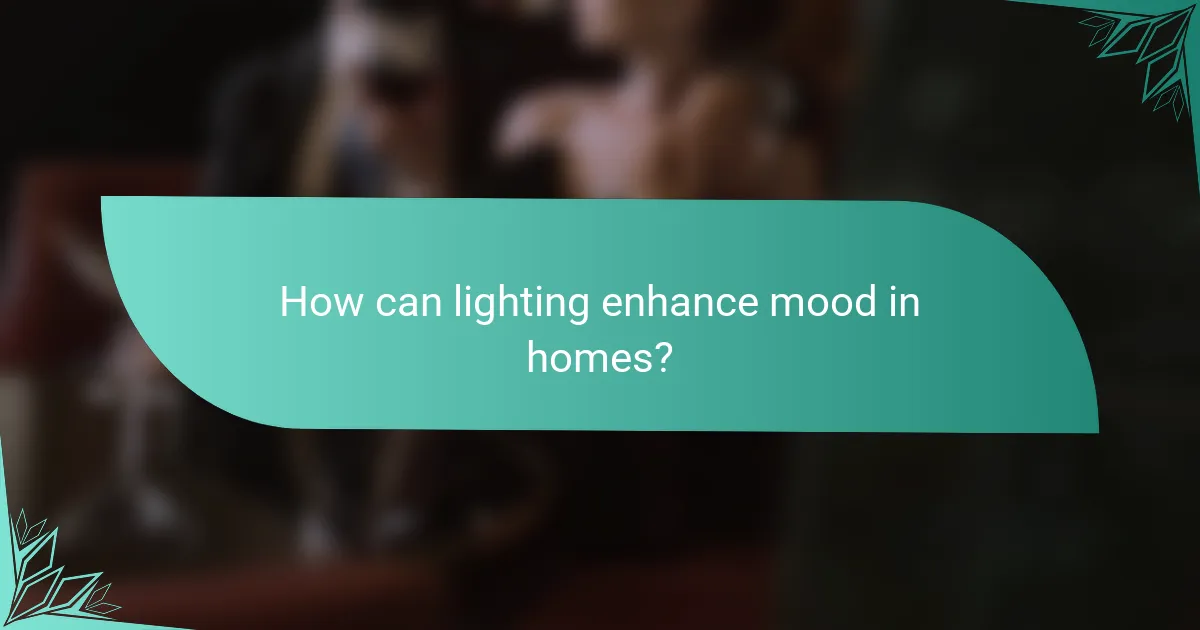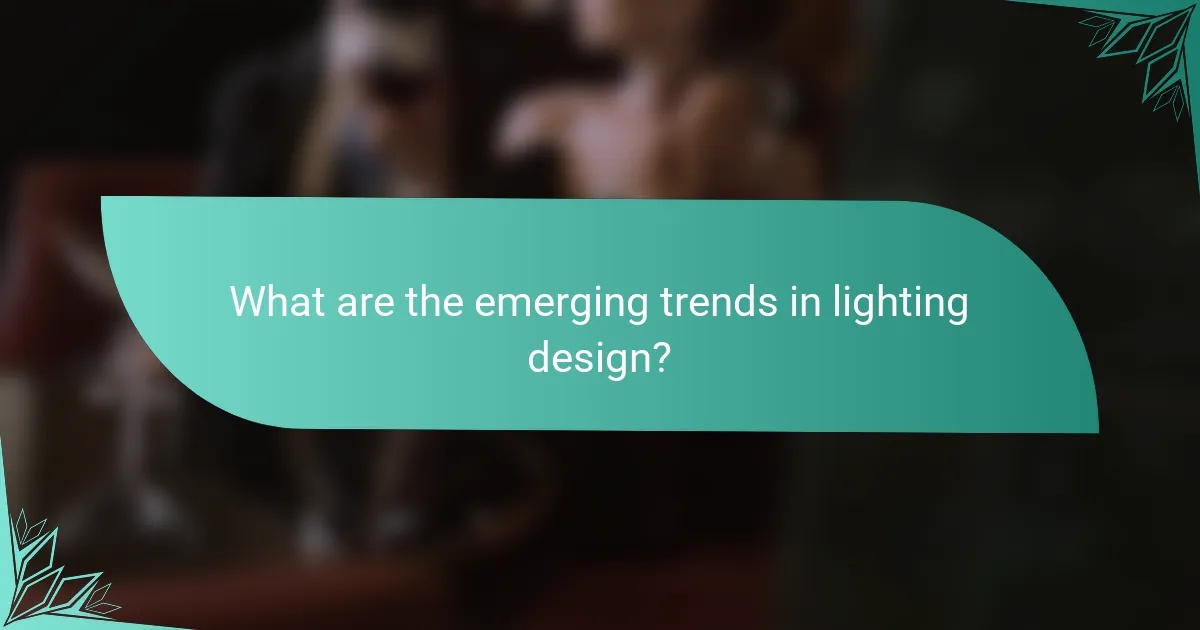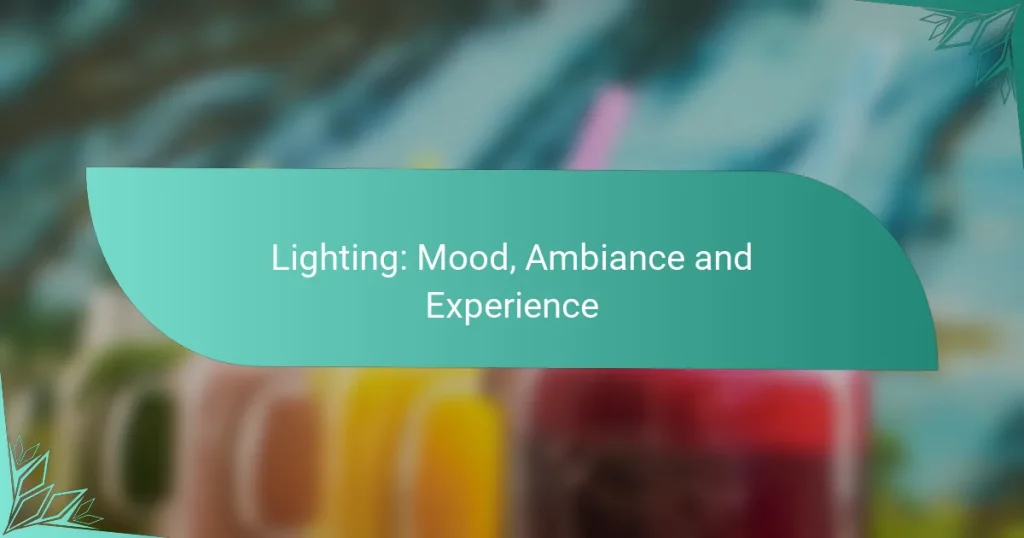Lighting plays a crucial role in shaping mood and ambiance within any space, whether at home or in a restaurant. By carefully selecting the type and intensity of light, one can create environments that feel warm, inviting, or energizing. Different lighting categories, such as ambient, accent, and task lighting, each contribute uniquely to the overall experience, enhancing comfort and interaction.

How can lighting enhance mood in homes?
Lighting can significantly enhance mood in homes by influencing emotions and creating a desired atmosphere. The right lighting choices can make spaces feel warm, inviting, or energizing, depending on the color temperature and techniques used.
Warm color temperatures
Warm color temperatures, typically ranging from 2700K to 3000K, create a cozy and inviting atmosphere. These tones mimic the glow of candlelight or sunrise, promoting relaxation and comfort, making them ideal for living rooms and bedrooms.
When selecting bulbs, consider options like incandescent or warm LED lights, which provide that soft, golden hue. Avoid cooler, bluish tones in spaces meant for relaxation, as they can be stimulating and may disrupt a calming environment.
Layered lighting techniques
Layered lighting involves combining ambient, task, and accent lighting to create depth and versatility in a room. Ambient lighting provides overall illumination, while task lighting focuses on specific areas for activities like reading or cooking, and accent lighting highlights artwork or architectural features.
To implement layered lighting, use ceiling fixtures for ambient light, table lamps for task lighting, and wall sconces or spotlights for accents. This approach allows you to adjust the mood based on activities or time of day, enhancing the overall experience in your home.
Smart lighting systems
Smart lighting systems offer customizable control over your home’s lighting, allowing you to adjust brightness, color, and schedules via apps or voice commands. These systems can enhance mood by enabling you to create specific lighting scenes for different occasions, such as movie nights or dinner parties.
Consider investing in smart bulbs that are compatible with existing fixtures, and explore options that allow for integration with home automation systems. This flexibility not only enhances ambiance but can also improve energy efficiency by allowing you to manage lighting more effectively.

What types of lighting create ambiance?
Various types of lighting can create ambiance by influencing the mood and atmosphere of a space. Key categories include ambient, accent, and task lighting, each serving distinct purposes while contributing to the overall experience.
Ambient lighting options
Ambient lighting provides the general illumination necessary for a space, setting the foundation for the overall atmosphere. Common options include ceiling-mounted fixtures, wall sconces, and floor lamps. Soft, warm bulbs (around 2700K to 3000K) are often preferred to create a cozy environment.
Consider dimmable fixtures to adjust brightness according to the time of day or activity. Layering ambient lighting with other types can enhance depth and visual interest in the room.
Accent lighting styles
Accent lighting is used to highlight specific features or areas within a space, such as artwork, architectural details, or plants. This type of lighting typically uses focused beams, such as spotlights or track lighting, to draw attention to these focal points.
When selecting accent lighting, aim for a contrast in brightness between the accent and ambient lighting to create visual interest. Use fixtures that allow for adjustable angles to direct light precisely where it is needed.
Task lighting solutions
Task lighting is designed to illuminate areas where specific activities occur, such as reading, cooking, or working. Desk lamps, under-cabinet lights, and pendant fixtures are common examples that provide focused light for tasks.
Ensure that task lighting is bright enough to reduce eye strain but not so harsh that it disrupts the ambiance. Position task lights to minimize shadows and glare, enhancing both functionality and comfort in the space.

How does lighting affect experiences in restaurants?
Lighting significantly influences the dining experience in restaurants by shaping mood and ambiance. Proper lighting can enhance comfort, encourage social interaction, and even affect food perception, making it a critical element in restaurant design.
Dim lighting for intimacy
Dim lighting creates a cozy and intimate atmosphere, ideal for romantic dinners or private conversations. Soft, warm light can make guests feel more relaxed and encourage longer stays, which can benefit the restaurant’s revenue.
To achieve this effect, consider using pendant lights or wall sconces with adjustable brightness. Aim for lighting levels around 30-50 lux for intimate settings, ensuring that the light is warm-toned to enhance the overall mood.
Colorful lighting for vibrancy
Colorful lighting can energize a space, making it suitable for lively gatherings or themed events. Bright, saturated colors can stimulate conversation and create a fun atmosphere, appealing particularly to younger demographics.
Incorporating LED strips or colored bulbs can help achieve this vibrancy. Use colors like red or orange to create excitement, while blues and greens can offer a more relaxed vibe. Balance is key; too much color can overwhelm the senses.
Adjustable lighting for events
Adjustable lighting is essential for accommodating various events and dining experiences. Being able to modify brightness and color temperature allows restaurants to tailor the ambiance to suit different occasions, from casual lunches to formal dinners.
Consider installing dimmers or smart lighting systems that can be programmed for specific events. For example, a wedding reception may require brighter, warmer lighting during dinner, transitioning to softer tones for dancing. This flexibility can significantly enhance guest satisfaction and engagement.

What are the best local lighting services in Los Angeles?
Los Angeles offers a variety of top-notch lighting services tailored to enhance mood, ambiance, and experience in both residential and commercial spaces. Whether you need design, installation, or specialized event lighting, there are skilled professionals ready to meet your needs.
Residential lighting design services
Residential lighting design services in Los Angeles focus on creating inviting and functional spaces within homes. These services often include consultations to assess the specific needs of the space, followed by tailored lighting plans that incorporate various fixtures, dimmers, and smart technology.
When selecting a residential lighting designer, consider their portfolio and experience with different styles, from modern to traditional. Look for professionals who understand the importance of layering light—combining ambient, task, and accent lighting to achieve a balanced effect.
Commercial lighting installation
Commercial lighting installation services are essential for businesses looking to create an appealing atmosphere while ensuring functionality. In Los Angeles, these services often involve energy-efficient solutions that comply with local regulations and help reduce operational costs.
Key factors to consider include the type of business and the desired ambiance. For example, retail spaces may benefit from bright, focused lighting to highlight products, while restaurants might opt for softer, warmer tones to create a cozy environment. Always ask about warranties and maintenance options when hiring a commercial lighting installer.
Event lighting specialists
Event lighting specialists in Los Angeles provide tailored lighting solutions for various occasions, from weddings to corporate events. These experts understand how to use lighting to enhance the mood and highlight key areas, such as stages or dining areas.
When hiring an event lighting specialist, discuss your vision and the specific atmosphere you want to create. They can offer options like uplighting, string lights, and intelligent lighting systems that adapt to the event’s flow. Ensure you review their previous work and ask for references to gauge their reliability and creativity.

What factors should be considered when choosing lighting?
Choosing lighting involves considering the room’s size and layout, the color schemes and decor, and energy efficiency ratings. Each factor plays a crucial role in creating the desired mood and ambiance while ensuring functionality and sustainability.
Room size and layout
The size and layout of a room significantly influence lighting choices. Larger spaces may require multiple light sources or fixtures to ensure even illumination, while smaller rooms can often rely on a single fixture or a combination of wall sconces and table lamps.
Consider the height of ceilings as well; higher ceilings may benefit from pendant lights or chandeliers that draw the eye upward, creating a sense of spaciousness. Conversely, lower ceilings might require flush mounts or recessed lighting to avoid a cramped feeling.
Color schemes and decor
Color schemes and decor impact how light is perceived in a space. Lighter colors reflect more light, making a room feel brighter and more open, while darker colors absorb light, which can create a cozy or intimate atmosphere.
When selecting lighting, think about the color temperature of the bulbs as well. Warm white lights (around 2700K) complement warm tones, while cooler lights (above 4000K) enhance cooler color palettes. This alignment can enhance the overall aesthetic and mood of the room.
Energy efficiency ratings
Energy efficiency ratings are essential for reducing electricity costs and environmental impact. Look for lighting options that are ENERGY STAR certified, as these products meet strict efficiency guidelines set by the U.S. Environmental Protection Agency.
LED bulbs are a popular choice due to their long lifespan and low energy consumption, often using up to 75% less energy than traditional incandescent bulbs. When choosing lighting, consider the initial cost versus long-term savings to make an informed decision.

What are the emerging trends in lighting design?
Emerging trends in lighting design focus on enhancing user experience through technology, sustainability, and personalization. Key developments include smart home integration, energy-efficient solutions, and adaptive lighting systems that respond to user needs and environmental changes.
Smart home integration
Smart home integration in lighting design allows users to control their lighting systems through smartphones, voice assistants, or automated schedules. This technology enhances convenience and energy efficiency, enabling users to adjust lighting based on their preferences or occupancy.
Consider systems compatible with popular platforms like Google Home or Amazon Alexa. These systems often include features such as dimming, color changing, and scene setting, which can significantly improve the ambiance of a space.
When implementing smart lighting, ensure that your Wi-Fi network is robust enough to support multiple devices. Avoid common pitfalls like overcomplicating setups or neglecting to update software, which can lead to connectivity issues.


